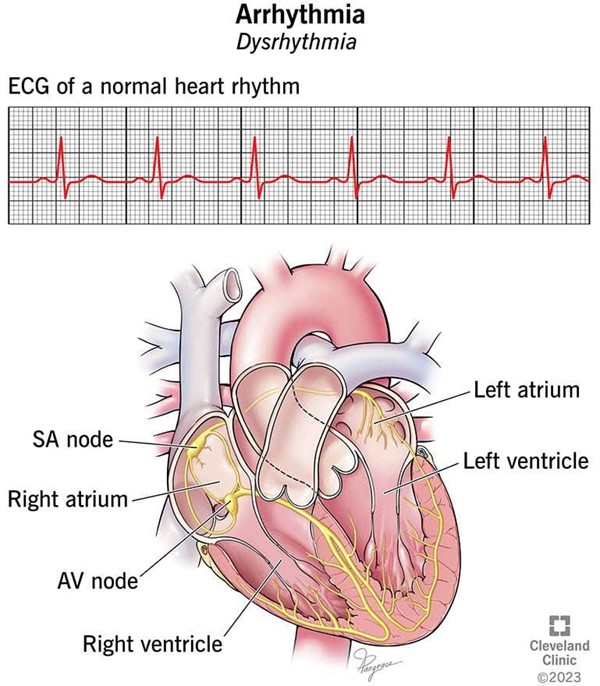A nurse is caring for a client at a follow-up visit who has been taking lithium therapy for bipolar disorder.
Which of the following findings should indicate to the nurse that the client is experiencing lithium toxicity?
Hypoglycemia.
Excess salivation.
Urinary retention.
Dysrhythmia.
The Correct Answer is D
Dysrhythmia is an abnormal heart rhythm that can be a sign of severe lithium toxicity.

Lithium toxicity can occur when a person takes too much lithium, a mood- stabilizing medication used to treat bipolar disorder and major depressive disorder.
Choice A is wrong because hypoglycemia is not a symptom of lithium toxicity. Hypoglycemia is low blood sugar that can cause symptoms such as shakiness, sweating, hunger, and confusion.
Choice B is wrong because excess salivation is not a symptom of lithium toxicity. Excess salivation can be caused by various factors, such as infections, medications, or nerve damage.
Choice C is wrong because urinary retention is not a symptom of lithium toxicity. Urinary retention is the inability to empty the bladder completely, which can cause pain, discomfort, and infection. Lithium toxicity can actually cause increased urine output, not decreased.
Normal ranges for blood lithium levels are 0.6 to 1.2 mEq/L for maintenance therapy and 0.8 to 1.5 mEq/L for acute therapy. Levels above 1.5 mEq/L can cause mild to moderate toxicity, and levels above 2.0 mEq/L can cause severe toxicity. Levels above 3.0 mEq/L are considered a medical emergency.
Nursing Test Bank
Naxlex Comprehensive Predictor Exams
Related Questions
Correct Answer is B
Explanation
Verapamil is a calcium channel blocker that can lower blood pressure and cause dizziness or fainting, especially when standing up from a sitting or lying position. Changing positions slowly can help prevent these symptoms.
Choice A is wrong because palpitations are not an expected side effect of verapamil, but rather a sign of a possible overdose or a serious heart problem that requires medical attention.
Choice C is wrong because verapamil should be taken with food or milk to avoid stomach upset and increase absorption.
Choice D is wrong because verapamil does not cause weight loss, but rather weight gain as a possible side effect.
Increasing calorie intake is not necessary and may worsen other health conditions such as diabetes or high cholesterol.
Correct Answer is A
Explanation
Proteinuria is the presence of excess protein in the urine, which is a hallmark of nephrotic syndrome. Nephrotic syndrome is a kidney disorder that causes increased permeability of the glomerular basement membrane, leading to loss of protein and other substances in the urine.
Choice B is wrong because hypolipidemia is a low level of lipids in the blood, which is not expected in nephrotic syndrome. On the contrary, nephrotic syndrome causes hyperlipidemia, which is a high level of lipids in the blood, due to increased synthesis and decreased clearance of lipoproteins.
Choice C is wrong because hyperalbuminemia is a high level of albumin in the blood, which is not expected in nephrotic syndrome. On the contrary, nephrotic syndrome causes hypoalbuminemia, which is a low level of albumin in the blood, due to loss of albumin in the urine and decreased synthesis by the liver.
Choice D is wrong because increased hemoglobin is not expected in nephrotic syndrome. On the contrary, nephrotic syndrome can cause anemia, which is a low level of hemoglobin in the blood, due to loss of iron and erythropoietin in the urine and decreased production of red blood cells by the bone marrow.
Normal ranges for proteinuria are less than 150 mg per day or less than 10 mg per deciliter on a random urine sample. Normal ranges for serum lipids are total cholesterol less than 200 mg per deciliter, LDL cholesterol less than 100 mg per deciliter, HDL cholesterol more than 40 mg per deciliter for men and more than 50 mg per deciliter for women, and triglycerides less than 150 mg per
deciliter. Normal ranges for serum albumin are 3.5 to 5.0 grams per deciliter.
Whether you are a student looking to ace your exams or a practicing nurse seeking to enhance your expertise , our nursing education contents will empower you with the confidence and competence to make a difference in the lives of patients and become a respected leader in the healthcare field.
Visit Naxlex, invest in your future and unlock endless possibilities with our unparalleled nursing education contents today
Report Wrong Answer on the Current Question
Do you disagree with the answer? If yes, what is your expected answer? Explain.
Kindly be descriptive with the issue you are facing.
